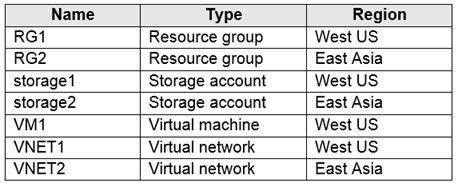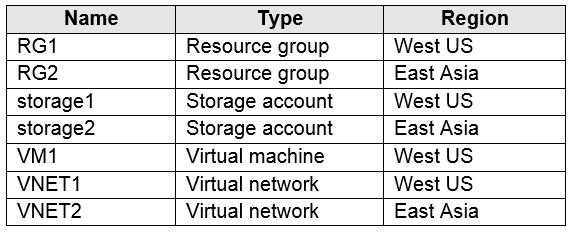You create an App Service plan named Plan1 and an Azure web app named webapp1.
You discover that the option to create a staging slot is unavailable.
You need to create a staging slot for Plan1.
What should you do first?
Answer:
A
The app must be running in the Standard, Premium, or Isolated tier in order for you to enable multiple deployment slots.
If the app isn't already in the Standard, Premium, or Isolated tier, you receive a message that indicates the supported tiers for enabling staged publishing. At this point, you have the option to select Upgrade and go to the Scale tab of your app before continuing.
Scale up: Get more CPU, memory, disk space, and extra features like dedicated virtual machines (VMs), custom domains and certificates, staging slots, autoscaling, and more.
Incorrect:
Scale out: Increase the number of VM instances that run your app. You can scale out to as many as 30 instances
Reference:
https://docs.microsoft.com/en-us/azure/app-service/deploy-staging-slots https://docs.microsoft.com/en-us/azure/app-service/manage-scale-up
You plan to move a distributed on-premises app named App1 to an Azure subscription.
After the planned move, App1 will be hosted on several Azure virtual machines.
You need to ensure that App1 always runs on at least eight virtual machines during planned Azure maintenance.
What should you create?
Answer:
C
An update domain is a logical group of underlying hardware that can undergo maintenance or be rebooted at the same time. As you create VMs within an availability set, the Azure platform automatically distributes your VMs across these update domains. This approach ensures that at least one instance of your application always remains running as the Azure platform undergoes periodic maintenance.
Reference:
http://www.thatlazyadmin.com/azure-fault-update-domains/
Note: This question is part of a series of questions that present the same scenario. Each question in the series contains a unique solution that might meet the stated goals. Some question sets might have more than one correct solution, while others might not have a correct solution.
After you answer a question in this section, you will NOT be able to return to it. As a result, these questions will not appear in the review screen.
You have an Azure virtual machine named VM1 that runs Windows Server 2016.
You need to create an alert in Azure when more than two error events are logged to the System event log on VM1 within an hour.
Solution: You create an event subscription on VM1. You create an alert in Azure Monitor and specify VM1 as the source
Does this meet the goal?
Answer:
B
Instead: You create an Azure Log Analytics workspace and configure the data settings. You install the Microsoft Monitoring Agent on VM1. You create an alert in
Azure Monitor and specify the Log Analytics workspace as the source.
Reference:
https://docs.microsoft.com/en-us/azure/azure-monitor/platform/agents-overview
Note: This question is part of a series of questions that present the same scenario. Each question in the series contains a unique solution that might meet the stated goals. Some question sets might have more than one correct solution, while others might not have a correct solution.
After you answer a question in this section, you will NOT be able to return to it. As a result, these questions will not appear in the review screen.
You have an Azure virtual machine named VM1. VM1 was deployed by using a custom Azure Resource Manager template named ARM1.json.
You receive a notification that VM1 will be affected by maintenance.
You need to move VM1 to a different host immediately.
Solution: From the Overview blade, you move the virtual machine to a different subscription.
Does this meet the goal?
Answer:
B
You would need to redeploy the VM.
Reference:
https://docs.microsoft.com/en-us/azure/virtual-machines/windows/redeploy-to-new-node
Note: This question is part of a series of questions that present the same scenario. Each question in the series contains a unique solution that might meet the stated goals. Some question sets might have more than one correct solution, while others might not have a correct solution.
After you answer a question in this section, you will NOT be able to return to it. As a result, these questions will not appear in the review screen.
You have an Azure virtual machine named VM1. VM1 was deployed by using a custom Azure Resource Manager template named ARM1.json.
You receive a notification that VM1 will be affected by maintenance.
You need to move VM1 to a different host immediately.
Solution: From the Redeploy blade, you click Redeploy.
Does this meet the goal?
Answer:
A
When you redeploy a VM, it moves the VM to a new node within the Azure infrastructure and then powers it back on, retaining all your configuration options and associated resources.
References:
https://docs.microsoft.com/en-us/azure/virtual-machines/windows/redeploy-to-new-node
Note: This question is part of a series of questions that present the same scenario. Each question in the series contains a unique solution that might meet the stated goals. Some question sets might have more than one correct solution, while others might not have a correct solution.
After you answer a question in this section, you will NOT be able to return to it. As a result, these questions will not appear in the review screen.
You have an Azure virtual machine named VM1. VM1 was deployed by using a custom Azure Resource Manager template named ARM1.json.
You receive a notification that VM1 will be affected by maintenance.
You need to move VM1 to a different host immediately.
Solution: From the Update management blade, you click Enable.
Does this meet the goal?
Answer:
B
You would need to redeploy the VM.
Reference:
https://docs.microsoft.com/en-us/azure/virtual-machines/windows/redeploy-to-new-node
You have an Azure subscription that contains a web app named webapp1.
You need to add a custom domain named www.contoso.com to webapp1.
What should you do first?
Answer:
A
You can use either a CNAME record or an A record to map a custom DNS name to App Service.
Reference:
https://docs.microsoft.com/en-us/Azure/app-service/app-service-web-tutorial-custom-domain
Note: This question is part of a series of questions that present the same scenario. Each question in the series contains a unique solution that might meet the stated goals. Some question sets might have more than one correct solution, while others might not have a correct solution.
After you answer a question in this section, you will NOT be able to return to it. As a result, these questions will not appear in the review screen.
You have an Azure subscription that contains the resources shown in the following table.
VM1 connects to VNET1.
You need to connect VM1 to VNET2.
Solution: You move VM1 to RG2, and then you add a new network interface to VM1.
Does this meet the goal?
Answer:
B
Instead you should delete VM1. You recreate VM1, and then you add the network interface for VM1.
Note: When you create an Azure virtual machine (VM), you must create a virtual network (VNet) or use an existing VNet. You can change the subnet a VM is connected to after it's created, but you cannot change the VNet.
Reference:
https://docs.microsoft.com/en-us/azure/virtual-machines/windows/network-overview
Note: This question is part of a series of questions that present the same scenario. Each question in the series contains a unique solution that might meet the stated goals. Some question sets might have more than one correct solution, while others might not have a correct solution.
After you answer a question in this section, you will NOT be able to return to it. As a result, these questions will not appear in the review screen.
You have an Azure subscription that contains the resources shown in the following table.
VM1 connects to VNET1.
You need to connect VM1 to VNET2.
Solution: You delete VM1. You recreate VM1, and then you create a new network interface for VM1 and connect it to VNET2.
Does this meet the goal?
Answer:
A
You should delete VM1. You recreate VM1, and then you add the network interface for VM1.
Note: When you create an Azure virtual machine (VM), you must create a virtual network (VNet) or use an existing VNet. You can change the subnet a VM is connected to after it's created, but you cannot change the VNet.
Reference:
https://docs.microsoft.com/en-us/azure/virtual-machines/windows/network-overview
Note: This question is part of a series of questions that present the same scenario. Each question in the series contains a unique solution that might meet the stated goals. Some question sets might have more than one correct solution, while others might not have a correct solution.
After you answer a question in this section, you will NOT be able to return to it. As a result, these questions will not appear in the review screen.
You have an Azure subscription that contains the resources shown in the following table.
VM1 connects to VNET1.
You need to connect VM1 to VNET2.
Solution: You turn off VM1, and then you add a new network interface to VM1.
Does this meet the goal?
Answer:
B
Instead you should delete VM1. You recreate VM1, and then you add the network interface for VM1.
Note: When you create an Azure virtual machine (VM), you must create a virtual network (VNet) or use an existing VNet. You can change the subnet a VM is connected to after it's created, but you cannot change the VNet.
Reference:
https://docs.microsoft.com/en-us/azure/virtual-machines/windows/network-overview